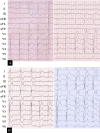Clinical characteristics and therapeutic strategy of frequent accelerated idioventricular rhythm
- PMID: 34496747
- PMCID: PMC8427942
- DOI: 10.1186/s12872-021-02221-0
Clinical characteristics and therapeutic strategy of frequent accelerated idioventricular rhythm
Abstract
Background: Accelerated idioventricular rhythm (AIVR) is often transient, considered benign and requires no treatment. This observational study aims to investigate the clinical manifestations, treatment, and prognosis of frequent AIVR.
Methods: Twenty-seven patients (20 male; mean age 32.2 ± 17.0 years) diagnosed with frequent AIVR were enrolled in our study. Inclusion criteria were as follows: (1) at least three recordings of AIVR on 24-h Holter monitoring with an interval of over one month between each recording; and (2) resting ectopic ventricular rate between 50 to 110 bpm on ECG. Electrophysiological study (EPS) and catheter ablation were performed in patients with distinct indications.
Results: All 27 patients experienced palpitation or chest discomfort, and two had syncope or presyncope on exertion. Impaired left ventricular ejection fraction (LVEF) was identified in 5 patients, and LVEF was negatively correlated with AIVR burden (P < 0.001). AIVR burden of over 73.8%/day could predict impaired LVEF with a sensitivity of 100% and specificity of 94.1%. Seventeen patients received EPS and ablation, five of whom had decreased LVEF. During a median follow-up of 60 (32, 84) months, LVEF of patients with impaired LV function returned to normal levels 6 months post-discharge, except one with dilated cardiomyopathy (DCM). Two patients died during follow-up. The DCM patient died due to late stage of heart failure, and another patient who refused ablation died of AIVR over-acceleration under fever.
Conclusions: Frequent AIVR has unique clinical manifestations. AIVR patients with burden of over 70%, impaired LVEF, and/or symptoms of syncope or presyncope due to over-response to sympathetic tone should be considered for catheter ablation.
Keywords: Accelerated idioventricular rhythm; Catheter ablation; Electrophysiology; Ventricular arrhythmia.
© 2021. The Author(s).
Conflict of interest statement
The authors declare no competing interests.
Figures






Similar articles
-
Frequent accelerated idioventricular rhythm in an otherwise healthy child: a case report and review of literature.BMC Cardiovasc Disord. 2023 Jan 20;23(1):37. doi: 10.1186/s12872-023-03074-5. BMC Cardiovasc Disord. 2023. PMID: 36670379 Free PMC article. Review.
-
Idiopathic accelerated idioventricular rhythm or ventricular tachycardia originating from the right bundle branch: unusual type of ventricular arrhythmia.Circ Arrhythm Electrophysiol. 2014 Dec;7(6):1159-67. doi: 10.1161/CIRCEP.114.002112. Epub 2014 Nov 6. Circ Arrhythm Electrophysiol. 2014. PMID: 25378469
-
Accelerated idioventricular rhythm requiring catheter ablation in a child: The dark side of a benign arrhythmia.Ann Cardiol Angeiol (Paris). 2017 Nov;66(5):323-325. doi: 10.1016/j.ancard.2017.09.002. Epub 2017 Oct 10. Ann Cardiol Angeiol (Paris). 2017. PMID: 29029776
-
Accelerated idioventricular rhythm: a benign arrhythmia in childhood.Pediatrics. 1995 Jul;96(1 Pt 1):122-5. Pediatrics. 1995. PMID: 7596699
-
[Accelerated idioventricular rhythm].Z Kardiol. 1994 Dec;83(12):898-907. Z Kardiol. 1994. PMID: 7846928 Review. German.
Cited by
-
Frequent accelerated idioventricular rhythm in an otherwise healthy child: a case report and review of literature.BMC Cardiovasc Disord. 2023 Jan 20;23(1):37. doi: 10.1186/s12872-023-03074-5. BMC Cardiovasc Disord. 2023. PMID: 36670379 Free PMC article. Review.
-
Incidence and Predictors of Ventricular Arrhythmias in Transthyretin Amyloid Cardiomyopathy.J Clin Med. 2023 Jul 11;12(14):4624. doi: 10.3390/jcm12144624. J Clin Med. 2023. PMID: 37510739 Free PMC article.
-
Accelerated idioventricular rhythm as anginous substrate in elderly: Report of an unprecedented case.HeartRhythm Case Rep. 2023 Dec 28;10(3):217-221. doi: 10.1016/j.hrcr.2023.12.014. eCollection 2024 Mar. HeartRhythm Case Rep. 2023. PMID: 38496744 Free PMC article. No abstract available.
-
Accelerated Idioventricular Rhythm in a Young Athlete: Physiology or Pathology?JACC Case Rep. 2022 Nov 6;4(23):101657. doi: 10.1016/j.jaccas.2022.09.023. eCollection 2022 Dec 7. JACC Case Rep. 2022. PMID: 36507292 Free PMC article.
References
-
- Terkelsen CJ, Sørensen JT, Kaltoft AK, Nielsen SS, Thuesen L, Bøtker HE, Lassen JF. Prevalence and significance of accelerated idioventricular rhythm in patients with ST-elevation myocardial infarction treated with primary percutaneous coronary intervention. Am J Cardiol. 2009;104(12):1641–1646. doi: 10.1016/j.amjcard.2009.07.037. - DOI - PubMed
Publication types
MeSH terms
LinkOut - more resources
Full Text Sources

